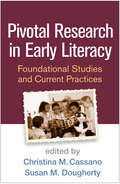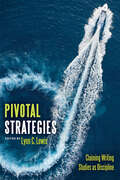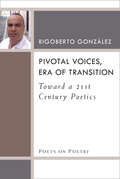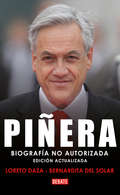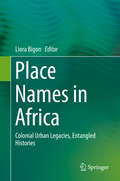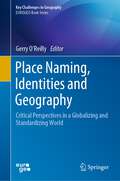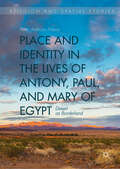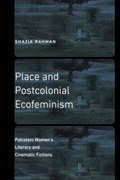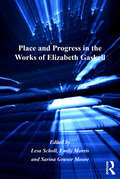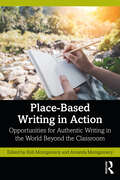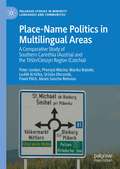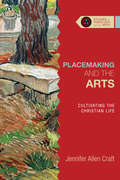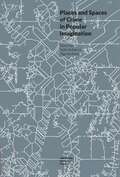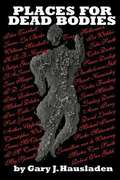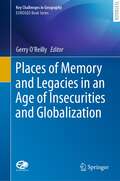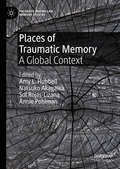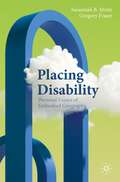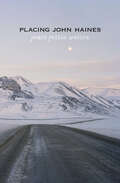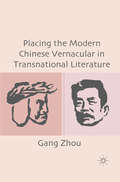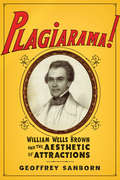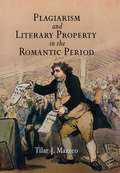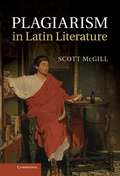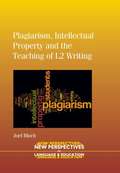- Table View
- List View
Pivotal Research in Early Literacy: Foundational Studies and Current Practices
by Christina M. Cassano Susan M. Dougherty Joanne Knapp-Philo Heidi Anne Mesmer M. M. Rose-McCullyThis reader-friendly text examines the key foundational studies in early literacy. It addresses such essential questions as how research informs current practices and where the field still needs to go to provide the best learning opportunities for all children. Each chapter describes the methods and findings of one to five seminal studies, critically assesses their long-term impact on practice and policy, and offers takeaways for the classroom. Leading authorities--including several authors of the original pivotal studies--cover 12 essential aspects of language development, literacy development, and home and community literacy experiences in PreK–2.
Pivotal Strategies: Claiming Writing Studies as Discipline
by Lynn C. LewisPivotal Strategies examines the rhetorical contexts and motivations that determine how and why people choose writing studies as a discipline, especially as the field begins to take more seriously an antiracist imperative that requires more conscious listening and promotion of work from scholars representing traditionally underrepresented voices. Because undergraduate degrees in writing studies are relatively new, claiming the discipline has required reinvention and revision at personal and professional levels far different than any other discipline. Suspicions about the viability of the discipline linger in many departments and universities, as well as outside the academy, leading writing studies scholars to develop innovative strategies to deal with covertly hostile attitudes. Within the collection, contributors name explicit claiming strategies from the discipline’s beginnings to the contemporary moment, locating opportune spaces, negotiating identities and fostering resilience, and developing allegiances by foregrounding their embodiment as underrepresented members of academia through a commitment to social justice and equity. Responding to current conversations on the worth of education with honest stories about the burdens and joys of becoming and being an academic, Pivotal Strategies features a spectrum of voices across racial, gender, class, and age categories. This collection not only makes the discipline more visible but also helps map the contemporary state of writing studies.
Pivotal Voices, Era of Transition: Toward a 21st Century Poetics
by Rigoberto GonzalezPivotal Voices, Era of Transition gathers Rigoberto González’s most important essays and book reviews, many of which consider the work of emerging poets whose identities and political positions are transforming what readers expect from contemporary poetry. A number of these voices represent intersectional communities, such as queer writers of color like Natalie Díaz, Danez Smith, Ocean Vuong, and Eduardo C. Corral, and many writers, such as Carmen Giménez Smith and David Tomás Martínez, have deep connections to their Latino communities. Collectively, these writers are enriching American poetry to reflect a more diverse, panoramic, and socially conscious literary landscape. Also featured are essays on the poets’ literary ancestors—including Juan Felipe Herrera, Alurista, and Francisco X. Alarcón—and speeches that address the need to leverage poetry as agency. This book fills a glaring gap in existing poetry scholarship by focusing exclusively on writers of color, and particularly on Latino poetry. González makes important observations about the relevance, urgency, and exquisite craft of the work coming from writers who represent marginalized communities. His insightful connections between the Latino, African American, Asian American, and Native American literatures persuasively position them as a collective movement critiquing, challenging, and reorienting the direction of American poetry with their nuanced and politicized verse. González’s inclusive vision covers a wide landscape of writers, opening literary doors for sexual and ethnic minorities.
Piñera. Biografía no autorizada
by María Loreto DazaLa edición actualizada de una biografía que expuso las contradicciones del nuevamente candidato a la presidencia de Chile Esta elogiada biografía #que se basa en más de cien entrevistas a familiares, amigos y adversarios#, repasa los entretelones más importantes de la vida del ex presidente y desgrana los sucesos más polémicos en los que se ha visto envuelto: el Banco de Talca, el #Piñeragate#, o los flancos que debió sortear al inicio de su presidencia con la venta de sus acciones de Blanco y Negro, LAN y Chilevisión. Con un nuevo capítulo que abarca la reconstrucción del país luego del terremoto de 8,8° en la escala de Richter ocurrido el 27 de febrero de 2010, la política de austeridad impulsada por su gobierno, las movilizaciones estudiantiles, el rescate de los treinta y tres mineros, la salida de los ministros #técnicos# y el importante crecimiento económico que marcó su gestión, las autoras de este libro #titulado anteriormente Piñera. Historia de un ascenso#, vuelven a perfilar a este controvertido empresario y político chileno, que con el transcurso de los años, y luego de aprender tanto de los éxitos y fracasos de su gobierno, #ya no pretende ganar siempre#.
Place Names in Africa
by Liora BigonThis volume examines the discursive relations between indigenous, colonial and post-colonial legacies of place-naming in Africa in terms of the production of urban space and place. It is conducted by tracing and analysing place-naming processes, particularly in sub-Saharan Africa during colonial times (British, French, Belgian, Portuguese), with a considerable attention to both the pre-colonial and post-colonial situations. By combining in-depth area studies research - some of the contributions are of ethnographic quality - with colonial history, planning history and geography, the authors intend to show that culture matters in research on place names. This volume goes beyond the recent understanding obtained in critical studies of nomenclature, normally based on lists of official names, that place naming reflects the power of political regimes, nationalism, and ideology.
Place Names: Approaches and Perspectives in Toponymy and Toponomastics
by Francesco Perono Cacciafoco Francesco CavallaroWhat are place names? From where do they originate? How are they structured? What do they signify? How important are they in our life? This groundbreaking book explores these compelling questions and more by providing a thorough introduction to the assumptions, theories, terminology, and methods in toponymy and toponomastics – the studies of place names, or toponyms. It is the first comprehensive resource on the topic in a single volume, and explores the history and development of toponyms, focusing on the conceptual and methodological issues pertinent to the study of place names around the world. It presents a wide range of examples and case studies illustrating the structure, function, and importance of toponyms from ancient times to the present day. Wide ranging yet accessible, it is an indispensable source of knowledge for students and scholars in linguistics, toponymy and toponomastics, onomastics, etymology, and historical linguistics.
Place Naming, Identities and Geography: Critical Perspectives in a Globalizing and Standardizing World (Key Challenges in Geography)
by Gerry O’ReillyThis book presents research on geographical naming on land and sea from a wide range of standpoints on: theory and concepts, case studies and education. Space and place naming or toponymy has a long tradition in the sciences and a renewed critical interest in geography and allied disciplines including the humanities. Place: location and cartographical aspects, etymology and geo-histories so salient in past studies, are now being enhanced from a range of radical perspectives, especially in a globalizing, standardizing world with Googlization and the consequent ‘normalization’ of place names, perceptions and images worldwide including those for marketing purposes. Nonetheless, there are conflicting and contesting voices. The interdisciplinary research is enhanced with authors from regional, national and international toponymy-related institutions and organizations including the UNGEGN, IGU, ICA and so forth.
Place and Identity in the Lives of Antony, Paul, and Mary of Egypt: Desert as Borderland (Religion and Spatial Studies)
by Peter Anthony MenaIn this book, Peter Anthony Mena looks closely at descriptions of space in ancient Christian hagiographies and considers how the desert relates to constructions of subjectivity. By reading three pivotal ancient hagiographies—the Life of Antony, the Life of Paul the Hermit, and the Life of Mary of Egypt—in conjunction with Gloria Anzaldúa’s ideas about the US/Mexican borderlands/la frontera, Mena shows readers how descriptions of the desert in these texts are replete with spaces and inhabitants that render the desert a borderland or frontier space in Anzaldúan terms. As a borderland space, the desert functions as a device for the creation of an emerging identity in late antiquity—the desert ascetic. Simultaneously, the space of the desert is created through the image of the saint. Literary critical, religious studies, and historical methodologies converge in this work in order to illuminate a heuristic tool for interpreting the desert in late antiquity and its importance for the development of desert asceticism. Anzaldúa’s theories help guide a reading especially attuned to the important relationship between space and subjectivity.
Place and Postcolonial Ecofeminism: Pakistani Women's Literary and Cinematic Fictions (Expanding Frontiers: Interdisciplinary Approaches to Studies of Women, Gender, and Sexuality)
by Shazia RahmanWhile news reports about Pakistan tend to cover Taliban attacks and bombings, and academics focus on security issues, the environment often takes a backseat in media reportage and scholarship. In particular, Pakistani women’s attachment to their environment and their environmental concerns are almost always ignored. Shazia Rahman traces the ways in which Pakistani women explore alternative, environmental modes of belonging, examines the vitality of place-based identities within Pakistani culture, and thereby contributes to evolving understandings of Pakistani women—in relation to both their environment and to various discourses of nation and patriarchy. Through an astute analysis of such works as Sabiha Sumar’s Khamosh Pani (2003), Mehreen Jabbar’s Ramchand Pakistani (2008), Sorayya Khan’s Noor (2006), Uzma Aslam Khan’s Trespassing (2003), and Kamila Shamsie’s Burnt Shadows (2009), Rahman illuminates how Pakistani women’s creative works portray how people live with one another, deal with their environment, and intuit their relationship with the spiritual. She considers how literary and cinematic documentation of place-based identities simultaneously critiques and counters stereotypes of Pakistan as a country of religious nationalism and oppressive patriarchy. Rahman’s analysis discloses fresh perspectives for thinking about the relationship between social and environmental justice.
Place and Progress in the Works of Elizabeth Gaskell
by Lesa Scholl Emily MorrisCritical assessments of Elizabeth Gaskell have tended to emphasise the regional and provincial aspects of her writing, but the scope of her influence extended across the globe. Building on theories of space and place, the contributors to this collection bring a variety of geographical, industrial, psychological, and spatial perspectives to bear on the vast range of Gaskell’s literary output and on her place within the narrative of British letters and national identity. The advent of the railway and the increasing predominance of manufactory machinery reoriented the nation’s physical and social countenance, but alongside the excitement of progress and industry was a sense of fear and loss manifested through an idealization of the country home, the pastoral retreat, and the agricultural south. In keeping with the theme of progress and change, the essays follow parallel narratives that acknowledge both the angst and nostalgia produced by industrial progress and the excitement and awe occasioned by the potential of the empire. Finally, the volume engages with adaptation and cultural performance, in keeping with the continuing importance of Gaskell in contemporary popular culture far beyond the historical and cultural environs of nineteenth-century Manchester.
Place, Writing, and Voice in Oral History
by Shelley TrowerOral history provides a valuable way of understanding locality. This volume considers the importance of working closely with the specifics of place in the context of global issues including environmental concerns and new communication technologies. Developing interdisciplinary connections between oral history, literary studies, and geography, essays in this collection focus on how both oral and written narratives engage with particular places, ranging from Dartmoor and "the clay country" to the River Ouse, from London to the polar regions. Further, this collection considers how oral history interviews themselves - the sounds of voices - are recorded and listened to in particular places: on walks, in theatres, at home on the internet. In doing so, this volume highlights the importance of thinking methodically about place not only in terms of the content of interviews, but also their creation, dissemination, and reception.
Place-Based Writing in Action: Opportunities for Authentic Writing in the World Beyond the Classroom
by Rob Montgomery Amanda MontgomeryThis text presents a variety of ways for students to meet traditional instructional goals in writing while also learning how writing can help them become stewards of the natural world and advocates for their own communities. Built on a foundation of emerging research and theory and grounded in the lived reality of teachers, this book explores the material and virtual worlds as places that can be equally productive as sources for authentic writing. Readers will find place-based writing activities, lesson ideas, and samples of student work in every chapter. With practical and classroom-tested ideas, Place-Based Writing in Action is a useful text for preservice and in-service English teachers, as well as any educator who wants to move the act of writing beyond the four walls of the classroom.
Place-Name Politics in Multilingual Areas: A Comparative Study of Southern Carinthia (Austria) and the Těšín/Cieszyn Region (Czechia) (Palgrave Studies in Minority Languages and Communities)
by Peter Jordan Přemysl Mácha Marika Balode Luděk Krtička Uršula Obrusník Pavel Pilch Alexis Sancho ReinosoThis book explores the role of place names in the formation and maintenance of individual and group identities in multilingual and multi-ethnic situations. Using examples from Austria and Czechia as case studies, the authors examine the power of place names through an interdisciplinary and multi-methods approach that draws from the fields of anthropology, geography, sociolinguistics and toponomastics. The book contextualises both places within their social and political histories, and probes recent debates in the social sciences relating to place names, identity and power. It will be of interest to scholars and students focusing on place names and naming practices, minority communities and languages, and linguistic landscapes.
Placemaking and the Arts: Cultivating the Christian Life (Studies in Theology and the Arts)
by Jennifer Allen CraftWe are, each one of us, situated in a particular place.
Places and Spaces of Crime in Popular Imagination (Topographies of (Post)Modernity: Studies in 20th and 21st Century Literature in English)
by Olga Roebuck Šárka BubíkováThe publication Places and Spaces of Crime in Popular Imagination is part of the Topographies of (Post)Modernity: Studies in 20th and 21st Century Literature in English Series. The text reflects growing interest in popular literary genres not only among the readers, but mainly in literary research. This still rather under-researched area is now representing fertile grounds for various theoretical approaches. As the publication mainly declares its interest in crime-related genres, its focus on place is justifiable: it reflects the postmodern “spatial turn”, manifested in an increased emphasis on the location of crime, not necessarily in the sense of the crime scene itself, but as a socio-geographical place and space. The setting of crime has a specific and well-defined role in the traditional crime genres, but this role has been redefined in the modern versions of crime-related fiction. ranging from educating the reader in certain areas, bringing up current problems, deepening the psychological aspect of individual characters etc. The published volume brings forth various aspects of this new role of place in popular genres centering on crime and gives space to its deeper analysis. It is not the researchers´ objective to provide overviews of the history of the theoretical discussion of place and space in literature in general. Instead, although the essays do employ a variety of critical approaches, the collection strives to show practically how place and space is employed in the specific material of the selected works.The seven chapters are written by scholars from the Czech Republic, Poland and Slovakia. Two essays represent London as a topos and a chronotope in the works by contemporary British writers of crime fiction. The selection is to show how varied the literary London can be, albeit in the often rather formulaic popular genre. The essays also document a shift from the country setting typical for the British Golden Age of detective fiction to the more recent urban focus. One contribution focuses on the genre of spy novel to show how rendering of place and space can contribute to the genre’s typical atmosphere of suspense, secrets and disquiet. Four more essays analyze a variety of places and spaces in American crime fiction, crime comics and crime film. All of the places are in some way specific to American milieu – the suburbia, the university campus, the wilderness, a holiday resort with a state park. These essays are designed to show the contemporary variety of places where crime literature (or film) is set and to document a shift from the traditional urban setting of American hard-boiled fiction to a far greater recent diversity.The volume brings together most recent central European research on the topic of place and community in popular imagination. Thus, it represents a unique insight into this growing phenomenon, which can no longer be overlooked by the academic community.
Places for Dead Bodies
by Gary HausladenFrom Tony Hillerman's Navajo Southwest to Martin Cruz Smith's Moscow, an exotic, vividly described locale is one of the great pleasures of many murder mysteries. Indeed, the sense of place, no less than the compelling character of the detective, is often what keeps authors writing and readers reading a particular series of mystery novels. <P><P> This book investigates how "police procedural" murder mysteries have been used to convey a sense of place. Gary Hausladen delves into the work of more than thirty authors, including Tony Hillerman, Martin Cruz Smith, James Lee Burke, David Lindsey, P. D. James, and many others. Arranging the authors by their region of choice, he discusses police procedurals set in America, the United Kingdom and Ireland, Europe, Moscow, Asia, and selected locales in other parts of the world, as well as in historical places ranging from the Roman Empire to turn-of-the-century Cairo.
Places of Memory and Legacies in an Age of Insecurities and Globalization (Key Challenges in Geography)
by Gerry O’ReillyIn this book, practitioners and students discover perspectives on landscape, place, heritage, memory, emotions and geopolitics intertwined in evolving citizenship and democratization debates. This volume shows how memorialization can contribute to wider inclusive interpretations of history, tourism and human rights promoted by the European Project. It's geographies of memories can foster cooperation as witnessed throughout Europe during the 2014-18 WWI commemorations. Due to new world orders, geopolitical reconfigurations and ideals that emerged after 1918, many countries ranging from the Baltic and Russia to the Balkans, Turkey and Greece, eastern and central Europe to Ireland are continuing with commemorations regarding their specific memories in the wider Europe. Shared memorial spaces can act in post conflict areas as sites of reconciliation; nonetheless `the peace' cannot be taken for granted with insecurities, globalization, and nationalisms in the USA and Russia; the UK's Brexit stress and populist movements in Western Europe, Visegrád and Balkan countries. Citizen-fatigue is reflected in socio-political malaise mirrored in France's Yellow Vest movement and elsewhere. Empathy with other peoples' places of memory can assist citizens learn from the past. Memory sites promoted by the EU, Council of Europe and UNESCO may tend to homogenize local memories; nevertheless, they act as vectors in memorialization, stimulating debate and re-evaluating narratives. This textbook combines geographical, inter-cultural and inter-disciplinary approaches and perspectives on spaces of memory by a range of authors from different countries and traditions offers the reader diverse and holistic perspectives on cultural geography, dynamic geopolitics, globalization and citizenship.
Places of Traumatic Memory: A Global Context (Palgrave Macmillan Memory Studies)
by Annie Pohlman Amy L. Hubbell Natsuko Akagawa Sol Rojas-LizanaThis volume explores the relationship between place, traumatic memory, and narrative. Drawing on cases from Africa, Asia, Europe, Oceania, and North and South America, the book provides a uniquely cross-cultural and global approach. Covering a wide range of cultural and linguistic contexts, the volume is divided into three parts: memorial spaces, sites of trauma, and traumatic representations. The contributions explore how acknowledgement of past suffering is key to the complex inter-relationship between the politics of memory, expressions of victimhood, and collective memory. Contributors take note of differing aspects of memorial culture, such as those embedded in war memorials, mass grave sites, and exhibitions, as well as journalistic, literary and visual forms of commemorations, to investigate how narratives of memory can give meaning and form to places of trauma.
Placing Disability: Personal Essays of Embodied Geography (Literary Disability Studies)
by Susannah B. Mintz Gregory FraserPlacing Disability presents an international collection of personal essays that address the experience of disability in particular geographical locations. Each chapter engages the question of what it means to be disabled in a specific place, exploring issues of movement, work and play, community and activism, artistic production, love and marriage, access and social services, family and friendship, memory and aging—all informed by the places that people inhabit. The book is organized in terms of topographies and vistas, rather than being bound by the map, to emphasize the defining, constitutive effects of place. The authors included in Placing Disability hail from different countries, neighborhoods, climates, and landscapes; from various backgrounds and professions; from a range of disciplinary perspectives and strategies. They are trained as academics, literary critics, poets, students, public speakers, memoirists, educators, philosophers, administrators, and activists. Their essays refine our understanding of the complex dynamic between self and circumstance as they survey the impact of geographical region on their life experiences. This book is intended to be useful in creative-writing workshops, Disability Studies seminars, and classes on environmental literature, and to appeal to general readers of memoir as well as to scholars of contemporary body theory or the Anthropocene.
Placing John Haines
by James Perrin WarrenJohn Haines arrived in Alaska, fresh out of the Navy, in 1947, and established a homestead seventy miles southeast of Fairbanks. He stayed there nearly twenty-five years, learning to live off the country: hunting, trapping, fishing, gathering berries, and growing vegetables. Those years formed him as a writer—the interior of Alaska, and especially its boreal forest—marking his poetry and prose and helping him find his unique voice. Placing John Haines, the first book-length study of his work, tells the story of those years, but also of his later, itinerant life, as his success as a writer led him to hold fellowships and teach at universities across the country. James Perrin Warren draws out the contradictions inherent in that biography—that this poet so indelibly associated with place, and authentic belonging, spent decades in motion—and also sets Haines’s work in the context of contemporaries like Robert Bly, Donald Hall, and his close friend Wendell Berry. The resulting portrait shows us a poet who was regularly reinventing himself, and thereby generating creative tension that fueled his unforgettable work. A major study of a sadly neglected master, Placing John Haines puts his achievement in compelling context.
Placing the Modern Chinese Vernacular in Transnational Literature
by Gang ZhouThis is the first book to concentrate not only on the triumph of the vernacular in modern China but also on the critical role of the rise of the vernacular in world literature, invoking parallel cases from countries throughout Europe and Asia.
Plagiarama!: William Wells Brown and the Aesthetic of Attractions
by Geoffrey SanbornWilliam Wells Brown (1814–1884) was a vocal abolitionist, a frequent antagonist of Frederick Douglass, and the author of Clotel, the first known novel by an African American. He was also an extensive plagiarist, copying at least 87,000 words from close to 300 texts. In this critical study of Brown's work and legacy, Geoffrey Sanborn offers a novel reading of the writer's plagiarism, arguing the act was a means of capitalizing on the energies of mass-cultural entertainments popularized by showmen such as P. T. Barnum. By creating the textual equivalent of a variety show, Brown animated antislavery discourse and evoked the prospect of a pleasurably integrated world.Brown's key dramatic protagonists were the "spirit of capitalization"—the unscrupulous double of Max Weber's spirit of capitalism—and the "beautiful slave girl," a light-skinned African American woman on the verge of sale and rape. Brown's unsettling portrayal of these figures unfolded within a riotous patchwork of second-hand texts, upset convention, and provoked the imagination. Could a slippery upstart lay the groundwork for a genuinely interracial society? Could the fetishized image of a not-yet-sold woman hold open the possibility of other destinies? Sanborn's analysis of pastiche and plagiarism adds new depth to the study of nineteenth-century culture and the history of African American literature, suggesting modes of African American writing that extend beyond narratives of necessity and purpose, characterized by the works of Frederick Douglass and others.
Plagiarism and Literary Property in the Romantic Period
by Tilar J. MazzeoIn a series of articles published in Tait's Magazine in 1834, Thomas DeQuincey catalogued four potential instances of plagiarism in the work of his friend and literary competitor Samuel Taylor Coleridge. DeQuincey's charges and the controversy they ignited have shaped readers' responses to the work of such writers as Coleridge, Lord Byron, William Wordsworth, and John Clare ever since. But what did plagiarism mean some two hundred years ago in Britain? What was at stake when early nineteenth-century authors levied such charges against each other? How would matters change if we were to evaluate these writers by the standards of their own national moment? And what does our moral investment in plagiarism tell us about ourselves and about our relationship to the Romantic myth of authorship?In Plagiarism and Literary Property in the Romantic Period, Tilar Mazzeo historicizes the discussion of late eighteenth- and early nineteenth-century plagiarism and demonstrates that it had little in common with our current understanding of the term. The book offers a major reassessment of the role of borrowing, textual appropriation, and narrative mastery in British Romantic literature and provides a new picture of the period and its central aesthetic contests. Above all, Mazzeo challenges the almost exclusive modern association of Romanticism with originality and takes a fresh look at some of the most familiar writings of the period and the controversies surrounding them.
Plagiarism in Latin Literature
by Scott McgillIn response to critics who charged him with plagiarism, Virgil is said to have responded that it was easier to steal Hercules' club than a line from Homer. This was to deny the allegations by implying that Virgil was no plagiarist at all, but an author who had done the hard work of making Homer's material his own. Several other texts and passages in Latin literature provide further evidence for accusations and denials of plagiarism. Plagiarism in Latin Literature explores important questions such as, how do Roman writers and speakers define the practice? And how do the accusations and denials function? Scott McGill moves between varied sources, including Terence, Martial, Seneca the Elder and Macrobius' Virgil criticism to explore these questions. In the process, he offers new insights into the history of plagiarism and related issues, including Roman notions of literary property, authorship and textual reuse.
Plagiarism, Intellectual Property and the Teaching of L2 Writing
by Joel BlochPlagiarism and intellectual property law are two issues that affect every student and every teacher throughout the world. Both concepts are concerned with how we use texts - print, digital, visual, and aural - in the creation of new texts. And both have been viewed in strongly moral terms, often as acts of 'theft'. However, they also reflect the contradictory views behind norms and values and therefore are essential to understand when using all forms of texts both inside and outside the classroom. This book discusses the current and historical relationship between these concepts and how they can be explicitly taught in an academic writing classroom.
